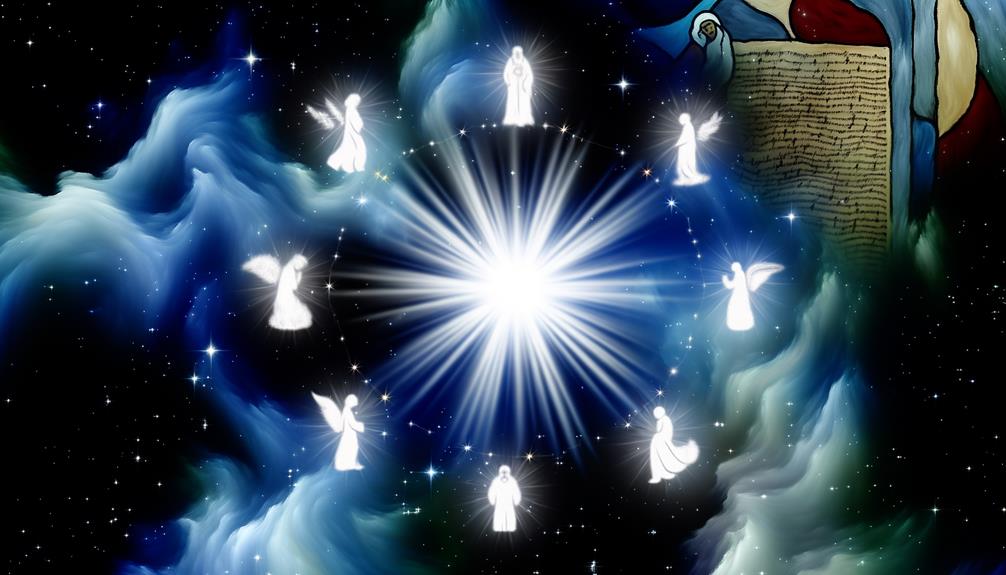Star Symbol Meaning in Bible: Guidance and Hope
In the Bible, stars hold deep theological and prophetic significance. The Star of Bethlehem, described in Matthew 2:1-12, guided the Magi to Jesus, symbolizing divine intervention and fulfillment of prophecy (Numbers 24:17).
God’s promise to Abraham in Genesis 15:5 likening his descendants to stars emphasizes the enduring legacy and divine favor. Stars also serve as divine messengers and symbols of God’s omnipresence (Judges 5:20; Revelation 1:20).
In prophetic visions, stars convey revelations and divine orchestration (Genesis 37:9; Revelation 12:1). They signify God’s unwavering covenant and perpetual assurance, entwining celestial imagery with spiritual truths.
Discover more insights by exploring further.

Biblical Meaning of the Star Symbol: Divine Guidance, Prophecy, and Jesus as the Morning Star
| Interpretation | Meaning | Explanation |
|---|---|---|
| Divine Guidance | Represents God’s guidance and direction. | The Star of Bethlehem guided the wise men to Jesus’ birthplace in Matthew 2:2, symbolizing divine guidance and God’s intervention in human affairs. |
| Jesus as the Morning Star | Symbolizes Jesus as the source of light, hope, and salvation. | Jesus is referred to as the “Morning Star” in Revelation 22:16, signifying His role as the bringer of light and eternal life. |
| Fulfillment of Prophecy | Reflects the fulfillment of messianic prophecy. | The appearance of the star during Jesus’ birth fulfilled Old Testament prophecies about the Messiah’s coming, as referenced in Numbers 24:17: “A star will come out of Jacob.” |
| God’s Presence and Glory | Represents God’s presence and glory in creation. | Stars in the Bible often symbolize God’s vastness and glory, as seen in Psalm 19:1, where “the heavens declare the glory of God” through the stars and the sky. |
| Promise of Descendants | Represents God’s promise of blessings and descendants. | Stars are used as a metaphor for abundance and blessings, such as in Genesis 15:5, where God promises Abraham that his descendants will be as numerous as the stars. |
The Star of Bethlehem

The Star of Bethlehem, also known as the Christmas Star, is described in the Gospel of Matthew as a celestial phenomenon that guided the Magi to the birthplace of Jesus Christ. This event is recorded in Matthew 2:1-12, where the star is said to have appeared in the east, leading the wise men to Jerusalem and then to Bethlehem.
Theologically, this star symbolizes divine intervention and guidance.
Historically, scholars have debated its nature, proposing explanations such as a supernova, planetary conjunction, or a miraculous event.
The star’s appearance fulfills Old Covenant prophecies, particularly Numbers 24:17, which speaks of a star rising out of Jacob.
Consequently, the Star of Bethlehem holds deep scriptural and historical significance in Christian tradition.
Abraham’s Descendants as Stars

In the biblical narrative, God promised Abraham that his descendants would be as numerous as the stars in the sky, a metaphor found in Genesis 15:5 that underscores both the vastness of his lineage and the divine blessing bestowed upon him.
This celestial imagery emphasizes God’s covenant with Abraham, signifying an innumerable and enduring legacy.
Historically, this promise not only conveyed the scope of Abraham’s progeny but also reinforced the divine favor and protection over his lineage.
The star imagery is deeply rooted in the ancient Near Eastern context, where stars were seen as symbols of perpetuity and divine presence.
Consequently, Abraham’s descendants as stars represent an eternal and divinely ordained promise, reflecting God’s unwavering commitment to His people.
Stars as Divine Messengers

Scriptural accounts frequently depict stars as divine messengers, embodying God’s will and signaling pivotal events throughout biblical history.
In the Old Covenant, the star that guided the Magi to Bethlehem (Matthew 2:2) served as a celestial herald for the birth of Jesus Christ. Similarly, Judges 5:20 describes stars fighting from heaven, emphasizing divine intervention in earthly matters. In Revelation 1:20, stars symbolize angels of the seven churches, illustrating spiritual oversight and guidance.
Witnessing the Star of Bethlehem, a symbol of divine promise fulfilled, showcases the importance of celestial signs in scripture.
Stars in biblical narratives often serve as beacons of hope and divine intervention, reflecting the human experience of seeking guidance in times of need.
Furthermore, the use of stars signifies God’s omnipresence, comfort, and guidance in times of uncertainty, reinforcing the notion that the divine is ever-present in the lives of believers.
These examples highlight the multifaceted role of stars as divine messengers in scripture.
Prophetic Visions of Stars

Prophetic visions throughout the Bible frequently employ stars as symbols to convey divine revelations and future events.
In Genesis 37:9, Joseph’s dream of stars bowing to him foreshadows his rise to prominence. Similarly, in Revelation 12:1, the woman adorned with twelve stars symbolizes Israel and her pivotal role in eschatological events.
Historically, stars have been seen as celestial markers of God’s intervention, as shown in Numbers 24:17, where a star signifies the coming of a ruler from Jacob.
These prophetic star symbols are not mere astronomical phenomena but are deeply embedded in the theological narrative, offering insight into God’s plans and purposes.
Therefore, stars in prophetic visions serve as profound indicators of divine orchestration in biblical prophecy.
Stars Signifying God’s Covenant

God’s covenant with Abraham is poignantly symbolized by stars, as seen in Genesis 15:5 where the innumerable stars represent his countless descendants. This celestial imagery underscores divine promises and the vastness of God’s blessings. The stars serve as a perpetual reminder of divine faithfulness and the unfolding plan of salvation history through Abraham’s lineage.
- Awe-inspiring Promise: Reflects the boundless nature of God’s blessings.
- Perpetual Reminder: Every night sky reiterates divine faithfulness.
In theological terms, the stars transcend mere celestial bodies, symbolizing the eternal and unbreakable nature of God’s covenant.
This metaphor deeply connects the physical universe with spiritual assurances, providing believers with an enduring source of faith and inspiration.
Conclusion
In biblical texts, stars serve as multifaceted symbols, embodying the divine guidance of the Star of Bethlehem, the vast lineage of Abraham, and the celestial messengers of God’s will.
Prophetic visions and covenantal promises further underscore their profound theological significance.
These stellar symbols, acting as guiding lights, illuminate the intricate tapestry of divine-human relationships throughout scripture.
Consequently, understanding stars in the biblical context is akin to grasping the thread of a larger divine narrative, seamlessly woven into the fabric of faith.






